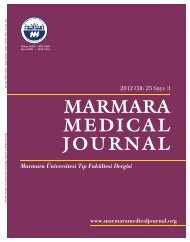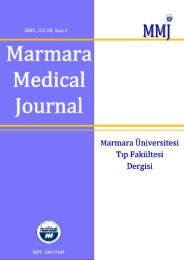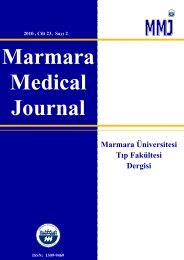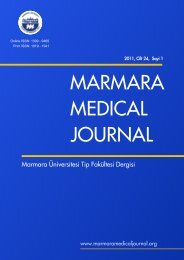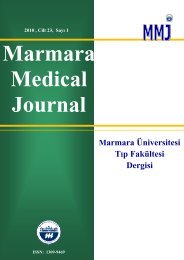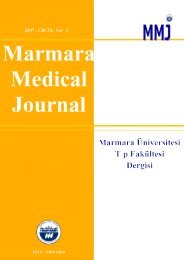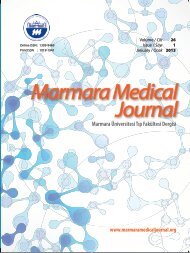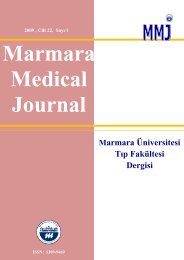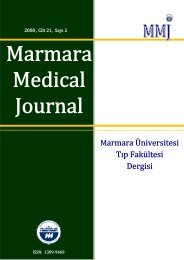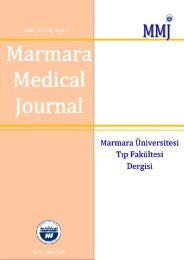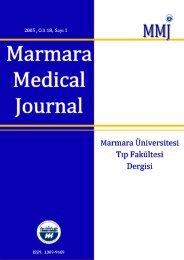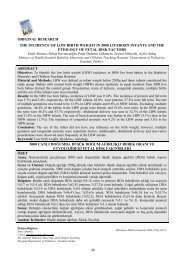Tam Metin PDF (4158 KB) - Marmara Medical Journal
Tam Metin PDF (4158 KB) - Marmara Medical Journal
Tam Metin PDF (4158 KB) - Marmara Medical Journal
- No tags were found...
Create successful ePaper yourself
Turn your PDF publications into a flip-book with our unique Google optimized e-Paper software.
G. MUMCU, et alOral health in patients with Behçet's diseaseINTRODUCTIONBehçet’s Disease (BD) is a multi-systemicvasculitic disorder characterized by oral and genitalulcers, cutaneous, ocular, arthritic, vascular, centralnervous system and gastrointestinalinvolvements 1,2 . The prevalence of BD is fairly highin Turkey, Israel, Iran, Korea and Japan comparedto USA and European countries. In addition, ocular,vascular and central nervous system involvements,reflecting a severe disease course, are morecommon in these countries 3-5 . Although theaetiology of BD is unknown, a role of infectiousagents is implicated in the etiopathogenesis and therecurrence of symptoms 1-6 .Since oral ulcers as a cardinal clinicalsymptom are commonly seen as the firstmanifestation of BD, oral flora 1-6 and oral health 2,4,5are implicated in the pathogenesis of BD.Streptococcia is the most commonly investigatedmicroorganism among members of the oral flora 1-9 .The high incidence of infection relating to tonsillitisand dental caries, relapse of disease manifestationsafter dental treatments 6-9 , clinical responses ofmucocutaneous symptoms to antimicrobialmedications 10,11,12 support the role of streptococciain the etiopathogenesis of BD. Colonization ofstreptococcia on the oral mucosa may trigger theimmune responses for ulcer formation in patientswith BD 6,7,9 . When oral health is examined, poordental and periodontal health is observed in patientswith BD 13-19 . Increased microbial plaqueaccumulation around the teeth which is a complexmicrobial ecosystem is found to be a risk factor for asevere disease course with major organinvolvement 13 . Besides, the number of oral ulcers isdecreased in a 6-month follow-up after dental andperiodontal treatments 14 . Although short term andcross sectional data regarding oral health havebeen obtained from different studies 11-19 , long termfollow-up data are not available for BD. Therefore,the aim of this study was to evaluate changes in oralhealth parameters in patients with Behçet’s diseasein a 10-year follow-up.PATIENTS and METHODSEighteen BD patients (F/M: 12/6, meanage: 36.4 ± 9.9 years) classified according to theInternational Study Group Criteria 20 and followedregularly by clinical, laboratory and oral healthexaminations for 10 years, were included in thestudy. These patients were examined and followedin multi-disciplinary Behçet’s Disease Clinic in<strong>Marmara</strong> University Hospital. Time interval betweenthe examinations was determined as 4-6 monthsaccording to disease activity and organ involvementof each of the BD patients. Both general and oralexaminations were carried out in each examinationduring the 10-year follow-up period. Parameters oforal health and general health were comparedbetween the first visit at baseline and the last visitafter the 10-year period in the study.Oral health was evaluated by dental andperiodontal indices as previously described 21 .Dental indices were the number of extracted teethand carious teeth. Plaque index, gingival index,sulcus bleeding index and periodontal pocket depthwere the periodontal indices. Patients were regularlygiven oral hygiene education regarding the methodsof tooth brushing and dental flossing and the effectsof cariogenic foods on oral health in each visit.In addition, the number of oral ulcers permonth was noted in each examination during thestudy period. A total clinical severity score reflectingorgan involvement was also determined in eachexamination according to Krause et al 22 .The exclusion criteria from the study werethe presence of other disorders affecting oral healthand irregular visits to the BD outpatients’ clinic. Thestudy was approved by the Local Ethics Committeeand informed consent was obtained.Statistical Analysis. Data were analysedby using the SPSS 11.5 statistic programme (SPSSInc, Chicago, IL). The Wilcoxon rank test and theChi-square test were used in comparisons betweenbaseline and follow-up. A p value equal or less than0.05 was accepted as significant.RESULTSScores for plaque index, gingival index,sulcus bleeding index and periodontal pocket depthwere similar at the 10-year follow-up (median: 2.1,2.3, 2.4 and 3.3, respectively) compared to those atbaseline (median: 2.5, 2.5, 2.3 and 3.2,respectively) (p=0.32, p=0.55, p=0.64 and p=0.87,respectively) (Table I). Similarly, no significantdifferences were present in the number of extractedteeth and carious teeth at baseline (median: 6 and2, respectively) when compared to follow-up(median: 7 and 2, respectively) (p=0.70 and p=0.32,respectively)(Table I).The frequency of tooth brushing was higherin the 10-year follow up (median: 1.2), than those ofbaseline (median:1.0), however without reachingstatistical significance (p=0.06) (Table 1).The number of oral ulcers in a month waslower at follow-up (median: 1) than at baseline(median:6) (p=0.000) (Table 1). Similarly, only halfof the patients had active oral ulcer at follow-up(n=10, 55.5%) compared to baseline (n=18, 100%)(p=0.002). However, disease severity score(median: 4), which demonstrates a cumulativepresence of various organ manifestations, waslower at baseline than the 10-year follow-up(median: 5)(p=0.000).22<strong>Marmara</strong> <strong>Medical</strong> <strong>Journal</strong> 2011; 24 (1):21-25



